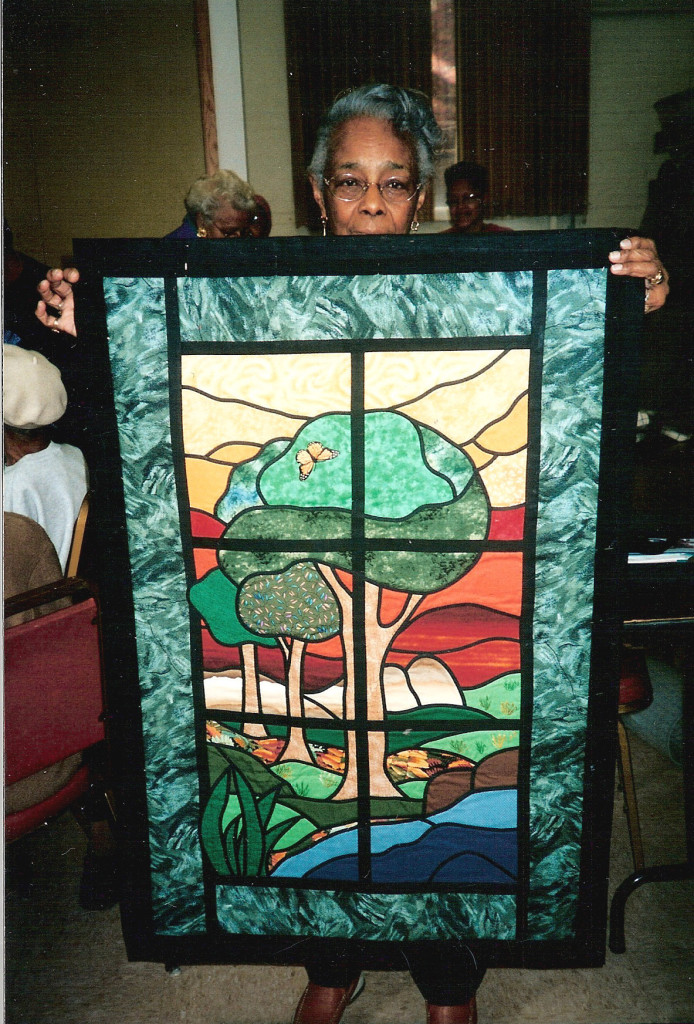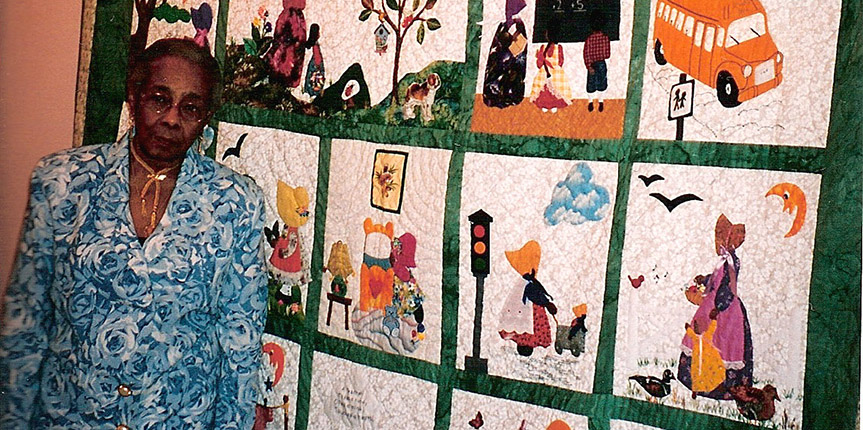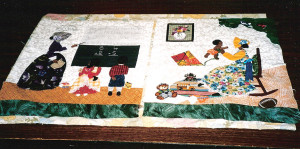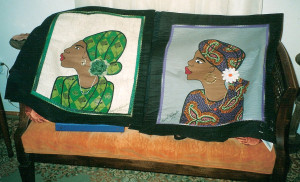
Carmel Washington, Stained Glass
Evelyn Salinger (ES): Today, November 16, 2004, we are having an interview with Carmel Washington in Northeast Washington, D.C. during a Daughters of Dorcas meeting. Her number is 20002-008. The interviewer is Evelyn Salinger. The time is 11:25 a.m. Hello, Carmel.
Carmel Washington (CW): Hi, Evelyn.
ES: How are you doing today?
CW: Fine, thank you.
ES: Good. I appreciate your agreeing to do this interview today. First, I would like to discuss what you brought today to show us. These are works in progress and they are very beautiful. Will you talk about the big wall hanging over there, first? Will you tell us what techniques you used there and what it is?
CW: This is a wall hanging and I used the stained glass design representing a landscape. I did enjoy doing it and using different colors, different shades and different kinds of material.
ES: The colors are certainly the wide spectrum from red all the way to deep blue.
CW: Yes.
ES: Is this a scene that you made up in your mind or is it some particular place that it represents?
CW: Yes. It just comes to me when I noticed in a postcard. And I decided to enlarge, because it was a small card, and make my own, using the design and making it a big landscape that would be a wall hanging, big enough for a large hall–a lot of space there.
ES: I think you have some embroidery on there, too.
CW: I did put some embroidery representing some grass, some patches, and the butterfly–about life–and the trees.
ES: Will you add more embroidery, still, since this is still a work in progress here?
CW: Still a work in progress. You know I do have to do the quilting part. And I use the embroidery design at the border. All of my wall hangings have the same kind of embroidery at the border, so to make them unique, and different from everybody else.
ES: Can you describe a little bit what you do at the border?
CW: It’s embroidery stitches.
ES: And it’s designs or is it part of the landscape itself on the border?
CW: No. It is just something that I add and distinguish my quilt because I never saw that–People ordinarily doesn’t use embroidery, mix embroidery in quilting, but I did because I used to teach embroidery.
ES: Yes. Good. I’d like to talk about the other thing you brought, and it is also a work in progress. And it’s–[interruption: voices.] Would you describe what you are going to make here?
CW: This is also–I have some friends who are retired teachers. I decided to do small wall hangings maybe because they have not enough large space on the wall, so that could be all small wall hangings that accommodate two, side by side. Or, if I choose to, I can have enough squares made to make a quilt.
ES: Ah. Let’s describe the first one up here. That’s a favorite for some of us. And it’s about a teacher, and it says, ‘A teacher takes a hand, opens a mind, touches a heart.’ And then you have over here, the other side–
CW: The alphabet. And the children learning and she has her “My Book.” So they are just in front of the blackboard representing that they are really interested in what the teacher–and I did that because I have been a teacher, myself, for a long time. And that particular design pleases. Some of my friends were teachers and want to think about what they did in life for a living.
ES: That certainly speaks to me. The little girl has a lovely braid. There are lots of three dimensional items on this patch.
CW: I like to, when I am quilting, to make it as real as possible because I like to create and by doing that, it just makes some kind of personalization and make it as real as I can be.
ES: It is certainly beautiful in colors and design.
CW: I enjoy matching colors for some reason. I have a sense of color. And sometimes I really go through so many bags of fabric just to get to the right piece that will make the finished product real.
ES: Do you have some sort of way of separating the different colors into your different bags that you save?
CW: No. [laughs.] I am,that is to say, I don’t think I am really organized. And sometimes I will go through the trouble of going through five, ten bags. And as soon as I finish to put them back, I remember that I need some–I saw something that can help another part of the design and have to go back to find something that I think will make the quilt pretty.
ES: That speaks to me, too, especially with appliqué. You need a special little piece some place and you have to search for it. Let’s just describe one more and we hope we will get a picture of these. This one is another one I think is a favorite of people’s.
CW: This is a grandmother. That design I did of a grandmother holding her grandson and ready for a bath and his toys and the family, little dog watching. And she is in her rocking chair.
ES: A rocking chair on this, even with a padded seat.
CW: Yes.
ES: In back. And she has a beautiful bonnet with a silk flower on it and lace at the bottom of her skirt. She’s playing with the little grandchild. That’s just beautiful.
CW: Yes. I made the sun at the corner of the window. There’s a tree and a bluebird.
ES: He’s singing his music notes.
CW: Yes.
ES: And then the wall over here has a potted flower plant.
CW: It’s really like a painting or decorated like a room because she is sitting on the carpet, on the rug and so that work is mostly on the inside.
ES: And the floral wall paper, which is a white on white. [fabric.]
CW: Yes.
ES: And the one thing we didn’t mention was the kite that’s here. What is the kite doing here with the little baby?
CW: The baby–she is holding different kinds of toys trying to entertain him and letting him get ready for his bath because we have the towels on the wall, hanging.
ES: That is lovely. Thank you so much for bringing this. These are so lovely and I hope to have a finished picture of this when you get done. I was going to ask you, what are your earliest memories of quilts?
CW: I really didn’t know anything about quilting because I used to teach embroidery. But it was about fifteen years ago when I saw–I met a lady at the store, and she was buying some fabrics. I saw my first–had an idea what was a quilt. I asked her how she can realize. And she told me that’s her quilting, and she will be the teacher, teaching a group of ladies at a friend’s house, who has a store. So in the back of the store, she was going to teach. And she invited me to be one of the group. So I went. The class lasted six weeks. And at first what caught my attention was in the back of the room. Somebody had a quilt on consignment. I never saw something so pretty. I couldn’t understand how somebody can realize something like that. But she was teaching piecing. And I really had a hard time because we were about twenty-five in the room and she didn’t have the time to pay attention and I’m really precise and I like to do good work. I wasn’t too pleased with what I was doing. After the six weeks, it was really discouraging. I didn’t understand anything. I didn’t know how to put the quilt together, she just was teaching the basics of piecing. Because I didn’t produce something that was up to my standard, being a picky person, [laughs.] and so I decided–she invited me because she belonged to a group, the Azalea Quilters, in Takoma Park. [Maryland.] And so I went and there were a group of ladies in meeting. That’s where I really started doing [inaudible.] but when I found out from the group that you can piece or do appliqué.
ES: Aha.
CW: And that really–I choose to do the appliqué because I used to do the same thing with embroidery, but using thread, because we were making sheets, tablecloths, and all kinds of linen dresses for the tourists, because I worked at the Department of Commerce in Haiti.
ES: For how long did you work for that?
CW: I was teaching full time at first, but they happened to close the school where I was teaching. And I got this work to the tourist place where I became the supervisor, working for the tourists. At that time we had we had big–and so I decided to use my technique in embroidery and apply it in doing appliqué. And I just really enjoy doing it and that’s the only class that I had in quilting. I practically taught myself. I still have my first quilt I made and it’s okay. It’s piecework, but the stitches are big. I didn’t really know what I was doing until I realized what is quilting. I would go to the stores and check about the books and the different quilting. So I developed my own method. And at that time also, it was when Georgia Bonesteel wrote a book. And she was teaching on TV the lap quilting method, because I don’t use a frame. And I did enjoy doing the lap quilting. Whatever the size, I mastered how to handle it. To handle a big quilt is not easy at first, but now I think there’s no problem. I used to work on–I was so interested that I was working on five quilts at a time.
ES: Oh, my.
CW: One every day and change every Monday the back so that way it wouldn’t be boring. I did pretty good because sometimes I would be finishing two or three quilts at a time. And now I just take my time and it doesn’t take me a long time to make a king-size quilt because I am sure of myself and have little finishing. And I don’t like sloppy work. So I will go back and if I see anything that is not to my standard, I will go in–[inaudible.] and so I made my own design. I like to create and make a full scene just out of one design. And make a little complete scene with appropriate different kind of–so I really enjoy creating.
ES: Uh-hum. You do pick up little butterflies and birds and things. [bell ringing.] Do you pick those up at a store? Do you have a favorite place where you get all these things?
CW: Yes. I used to make a lot of that until I discovered that I can go faster and make different things with finding original things that really enhance the design and make me go faster. And so that’s what I did.
ES: Would you at this point describe your day? How do you spend the day at quilting in general?
[bell ringing.]
CW: Some days, I used to start by seven o’clock and stop for dinner at about one and start again until sometimes ten or eleven o’clock. I was really obsessed with quilting. [more bells.] Now, some days, the only thing, because I am sure of what I am doing, sometimes I can do in two hours what somebody else can do in one day. And I can go fast and precise in doing the work.
ES: Uh-hum. Don’t you do other things besides? For instance, you have a routine of exercise and that sort of thing to keep yourself in shape?
CW: Yes. I don’t sew all day because I’m just too fast and sure of what I’m doing. Some times I only need two hours. But I do enjoy concentrating in creating. I cannot copy. I’m happiest when I’m creating my own design.
ES: Do you find that you dream your design sometimes?
CW: Yes. Sometimes I will be in bed thinking about what I want to do. I can see the full quilt.
ES: You can?
CW: Sometimes I’ll put it on paper. I don’t like to repeat the quilt because I lost interest, because I am not creating any more. I know I lost interest so mostly I have one of a kind design.
ES: Do you mostly make large quilts or do you do wall hangings?
CW: Wall hangings.
ES: I remember the series of women you did.
CW: Yes.
ES: Each woman was different but would you get bored with that?
CW: No, because they were dressed in different African attire, so it was–in fact, I made thirteen, but the embroidery–because the face is lined with embroidery–and that demanded a lot of attention and precision. You cannot have any shaky hands doing that, so I think for now, I don’t want to repeat them, maybe later on.
ES: Have you sold some of your works?
CW: Sometimes. Just with the idea to buy fabrics. And it used to be an addiction and I had to stop. I would go to the store and come back with three hundred dollars of fabric and really all my pocket money goes to buying fabric, so when I decide to really give a quilt for somebody, a friend, I use the money to supply, because I have a good, large supply of fabric because I don’t like to be making a quilt and go into the store. In fact, I can open the store [laughs.] with so much fabric. And some of them I don’t use. And when I cannot use them, I will give them to my church for bazaar. And also, I gave a few quilts I quilted to my church. So it’s really a very expensive hobby, very expensive. [laughs.]
ES: Would you tell us about how you learned your sewing skills as you were growing up in Haiti?
CW: Well, in Haiti, the first day, when you go to school, at five, you have a pencil and that same week, you have also a needle, because they teach seriously embroidery because you have to pass the test at the end of your high school. You have to pass the test of embroidery, so everybody has to learn. And I really had a gift to learn so quickly. I can open a book and reproduce what I saw just in the book to the point that I really am pleased to say to be so talented, a given talent. And everybody has to learn how to sew. And I got interested in that and learned and became a teacher after finishing and taught embroidery, not only embroidery, it was a part of my class. I had elementary, I had children between eight and ten, but it’s a part of one of my subjects to teach embroidery in the whole school, not only for my class, but the whole school.
ES: Oh, my.
CW: It was a challenge, but they had to pass the test, because if you miss the embroidery test, then you have to take everything again. Math and everything, so you’d better try to learn. It’s really, I remember my sister, who couldn’t master. She just didn’t like to do it, but she had to do it. After, when she didn’t need any more, she never touched a needle to do embroidery, because it was a hard pill for her while it was so easy for me.
ES: Uh-hum. Did they also teach you sewing machine skills?
CW: No. No sewing machines. Just embroidery. Sewing machine part, everybody needs to hand sew. But my sister became an expert in sewing. She was really a good seamstress. She made that as her living. She worked for the telephone company and her office was in our house, so she was there. She had sew hobby so that’s how she learned to sew. And she was an expert while I never liked sewing lessons, so we compensated for each other. She made my dresses and I made her trousseau before she got married. Everything she needed in her trousseau I made that.
ES: That’s just great. Do you keep track of all the things you’ve made? Do you keep photos or anything for yourself to remember?
CW: I have some photos. I’m not good at taking pictures, but I always have friends taking pictures, so I have a pretty good collection.
ES: It’s nice to remember, I think.
CW: Yes.
ES: Have you entered into shows?
CW: We have from time to time, we have a display once a week–but no.
ES: You’ve been in the Sumner School show.
CW: Yes.
ES: Have you ever had anything in the Smithsonian?
CW: Yes. They had a display of some vests that I made–but mostly at Sumner.
ES: When did you join the Daughters of Dorcas?
CW: After I left the Azalea Quilters, in Takoma, because some friend told me about that, I made the change because there were–and it was a nice group. They used to have hired people to do workshops, but they had a lot of elderly. At the end, they liked to socialize more than the quilting, so that’s when I decided to make the change and come to the Daughters of Dorcas.
ES: When you go to a quilt show and you see some quilts, what do you look for in a good quilt?
CW: For the stitches. I make a judgment about the size of them, because I am able to do the very, very tiny stitches and all the same size. The point I have people asking me, is it by machine? Do they not know I just enjoy doing good work? That when I finish to do a quilt, I don’t need somebody to tell me that it’s a good quilt, or a pretty quilt, and well done. I know it myself. So, I don’t like not well done work. But I know also, that not everybody can do, because also I mix embroidery with my quilting, so make them different. [bell ringing.] I try to help. I have some friends that I help them, but I think it is a really hard process if you try to learn embroidery at a late stage.
ES: As a senior citizen, for example.
CW: You cannot. [interruption in tape.]
ES: Now, about the stitches. You can be very forgiving of some of us who were not brought up doing the fine work.
CW: I realize that not everybody can. And I don’t like to criticize them because I am not perfect. And even in my quilting, I make mistakes. I have some mistakes. In fact, I tell somebody, they will not know. But I know when I have a mistake. I don’t judge people because I know that not everybody can do. It’s hard for me to change a light bulb, [laughs.] or to hold a tool to do any kind of work in the house. I cannot do it. So I realize that nobody’s perfect. [bell ringing.] We have to compensate for each other and help each other. Somebody can do something, and I can do something else.
ES: What do you think about the machine quilting people are doing now?
CW: I will not do it. I won’t even try. It’s pretty for somebody who likes it, but I prefer my method of the quilting.
ES: Would you have some advice for new quilters?
CW: Be patient. Patience and recognize when you do something wrong. Don’t say, ‘OK, I will do it better the next time.’ The first time, take time, and start over, because if you allow yourself to be careless in the first one, you will never change. There will always be some kind of lacking. So be patient. And have the desire that you want to do it right all the time. You try your best to do it well the first time, because don’t get complacent and say, ‘I will do it later, better.’ You will not.
ES: That is good advice.
CW: Take time and learn from somebody, instead of criticizing somebody. You learn from somebody. I am still learning. I like to go to shows and have ideas from other people. And that’s why sometimes I bring my work so somebody can learn something from my work, because I am learning all the time. Sometimes in a book, on TV, or I’m interested in what somebody is doing, because we don’t do things the same way. So I always learn from somebody else.
ES: And you find by coming to Daughters of Dorcas you are able to get ideas and give ideas?
CW: No question about that. Sure. I learn a lot.
ES: I know you have expressed that you really enjoy your time by yourself in creating.
CW: Yes, I do enjoy, in that once my mind is occupied, it is fine with me. I can do that the whole day, just concentrate, because of the situation if I am alone. I remember one day, it was at Christmas, and I was at home and called my sister to wish her Happy Christmas, Merry Christmas, and I could hear all her children there and they were having dinner, they’re laughing, and while I was here alone. I turned to tears because it was immediately feeling the loneliness, and immediately when I realized that I was being ungrateful and did not appreciate what I had, and I was working on a quilt. When I finished, I thought, well, she has her children, they are happy, but look what I can realize. So I am not completely alone. I have my share of happiness, too, because what she cannot do, what I am doing. I do not have her family. [laughs.] So I realize that I am still blessed.
ES: You certainly are. Thank you so much for your interview, very interesting.
CW: Thank you, Evelyn. It’s my pleasure.
12:00 noo



